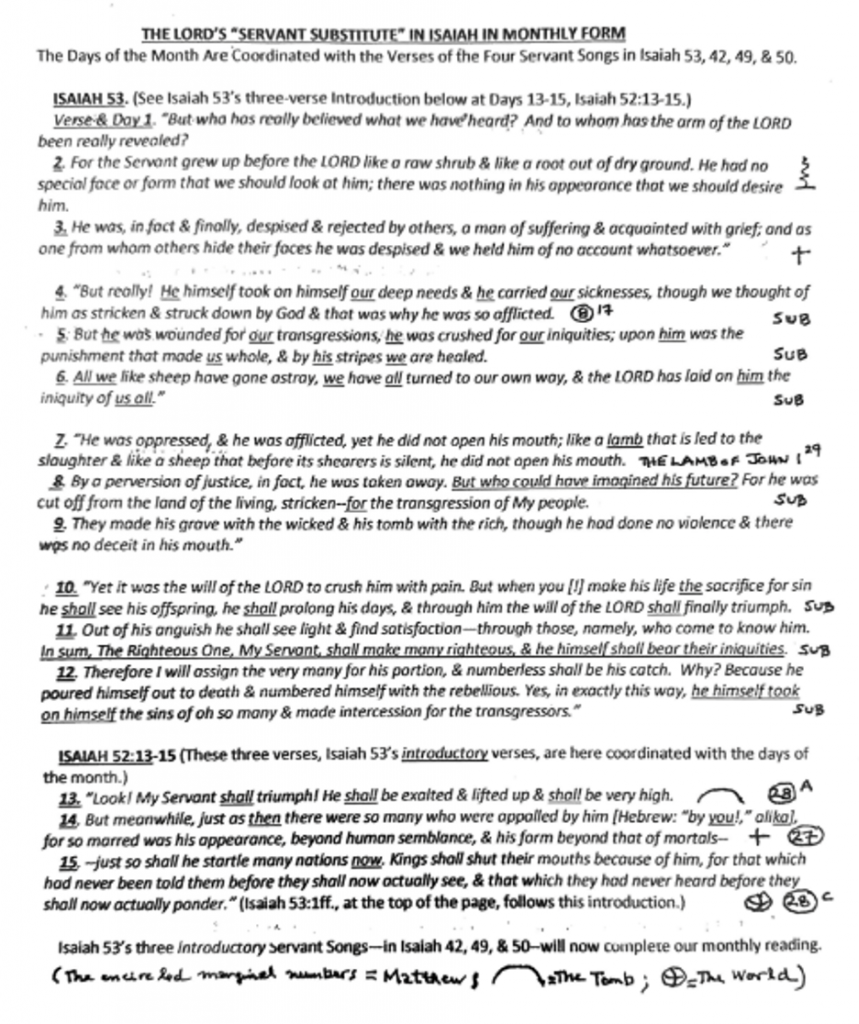We asked Dr. Dale Bruner, “What passage of Scripture could you study for the rest of your life?” He answered with his “Mount Everest” of Scripture by diving into the meaning of Isaiah 53 — and you can do the same!
THE MOUNT EVEREST OF SCRIPTURE
Dale Brunner, theologian, author, Bible teacher, and longtime friend of the mission of Young Life, has decided to study just one passage for the remainder of his life! Think of the options!
Your choice of 66 books, 40 authors, and literary genres ranging from poetical to prophetical, historical to the Gospels. Dale had just finished his commentary on Romans and was nearing the age of 90 (it does make it easier to commit to “the rest of your life”). He made a decision to focus his study on one passage as his final passion for his remaining years.
He chose a passage that was central to gaining a deeper understanding of the Life, Death, and Resurrection of Jesus.
HIS ANSWER: ISAIAH 53
In Dale’s words, Isaiah 53 towers like Mount Everest in Scripture, and for a man that has spent most of his life in a library separate from the real world, that is a powerful statement.
But what’s the meaning of Isaiah 53? And what does Isaiah 53 teach us?
THE SUFFERING SERVANT
When he started this unique study, the Fuller Seminary library still had limited access due to the pandemic so he began by translating the passage himself from Latin, Hebrew, and Greek, while using the NRSV as a guide.
His thrilling outcome was the realization that the calling of Jesus in Luke 4 (Where Jesus unrolled and read the scroll aloud in the temple) came from his understanding of the Old Testament prophecy in Isaiah 53 and the surrounding “servant songs.”

For decades, biblical scholars have recognized several passages in the latter half of Isaiah as “Servant Songs” which describe the “servant of Yahweh.” This suffering servant does the will of Yahweh, as the nation of Israel was called to do.
As the songs continue, the servant is better exemplified by the faithful remnant of Israel, and finally by an individual suffering servant who knows pain and suffering, takes punishment on behalf of others, heals others, and acts with wisdom and justice (Isaiah 42:1-4; 49:1-6; 50:4-9; and 52:13-53:12).
In Isaiah 53:5, we see how this servant is wounded on behalf of others’ sins and mistakes — but his wounds actually provide healing.
As the Bible unfolds, of course, we come to see that this servant is Jesus.
Bruner went on to describe that the main thought is that we are seeking to lift up Jesus Christ, but he came down, was born in an animal feed bin, and ended up crucified on a cross like a criminal. Jesus is eventually lifted up, but that comes only through going down — even being cut off from the land of the living. This shows the heart of God.
God’s way is always down.
SERVICE AND SUFFERING
This prophetic book is one of the most quoted books in the New Testament and the fourth Servant Song (in chapter 53) is quoted or referenced 43 times in the New Testament. The background of Isaiah is that it was addressed to people who had been disobedient and, therefore, had gone into exile. In the second part of the book, Isaiah expresses profound hope that Israel will be restored and ultimately fulfill God’s purpose.
In the final song (Isaiah 52:13-53:12) the personal pronouns — “we, our, us” on the one hand, and “he, his, him” on the other — require the interpretation that the servant is neither the blind nor deaf nation Israel, nor the righteous remnant or prophet called “Israel” but the true Israel, the obedient servant. Yet this servant does not work salvation by power or strength, but by service and suffering.
THE MESSAGE FOR THE CHURCH
The overwhelming message that is critical for the Church today is that God’s way is humble and lowly. The Greeks wanted “brilliance” in a Savior and the Jews wanted triumphant, but the message of Isaiah is not up, but lowly.
Interestingly, Dale sees a thread connecting God’s plan for salvation being tied to his other four books on John, Matthew, Romans, and the Holy Spirit. Additionally, he sees God’s authorship in the several notations where the text states “My servant.” This phrase is not attributed to Isaiah, but to the Lord himself.
It’s inspiring to witness how the reading of God’s Word fills Dale with excitement. Jesus clothes himself in the prophecy of Isaiah 53 by showing the fullness of the gospel in one passage!
A REMINDER FOR YOUNG LIFE
Generally, the people of Young Life talk more about the New Testament than the Old Testament, but in our affinity to focus on Christ-centric passages there may not be one more valuable than Isaiah 53. The message of humility and obedience is timeless — and timely for today!
Jesus, born in an animal feed bin, was crucified on a cross on a hill. The God we represent is countercultural. He identifies with the hurting, poor, and starving. This is disruptive to a self-centered society.
A 31-DAY CHALLENGE
So here is a 31-day challenge for YOU. In the linked PDFs, Dale has separated the 31 verses found in the servant songs in Isaiah broken down to one per day. One passage, in bite-size segments, to be digested over the course of a month.
You can download, bookmark, or print the two PDFs, and spend time each day with the next verse. The goal is to study, meditate, and sit with the text and go as deeply as you can. Remember, the goal isn’t to have an “aha!” moment, but to sit with God and his Word — just as Jesus would have.
Live with the verse every day, pray over it, memorize it if you can, and ultimately live from it.
- The Lord’s Servant Substitute in Isaiah (Page 1)
- Jesus’ Baptism and Transfiguration (Page 2)
TRY THIS: For the next month, dive deeply into these 31 verses of servant substitution and see what it does to your inspiration to get out there and go down into the world.







